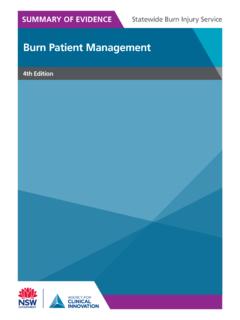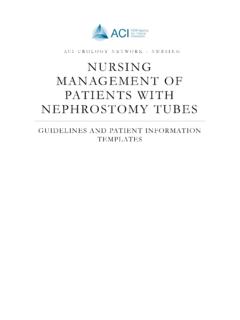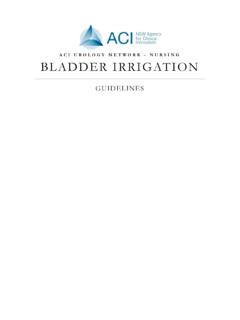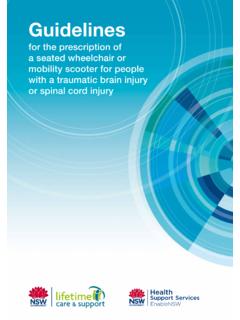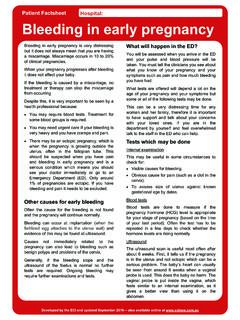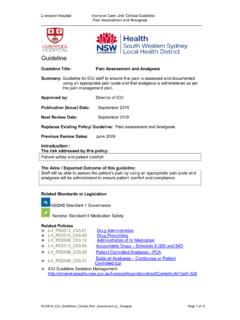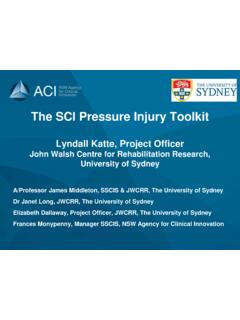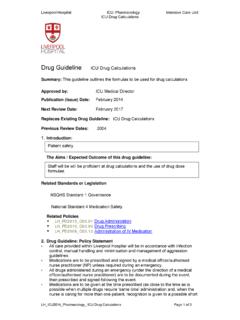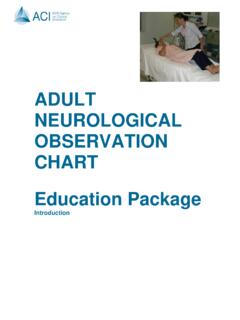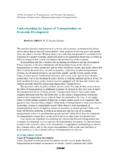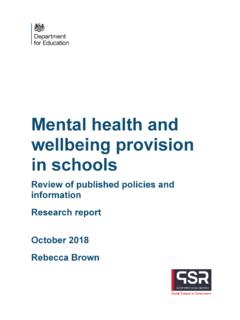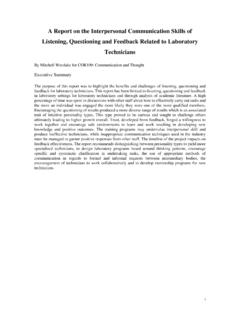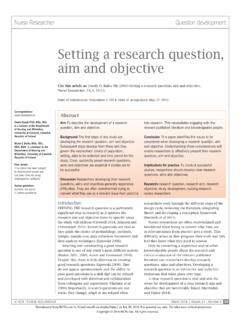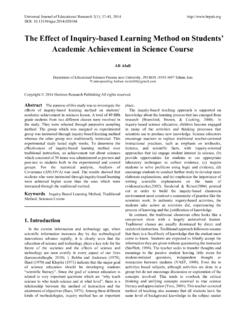Transcription of Care of the Person following Amputation - NSW Agency for ...
1 Care of the Person following Amputation Minimum Standards of Care The Agency for Clinical Innovation (ACI) works with clinicians, consumers and managers to design and promote better healthcare for NSW. It does this by: service redesign and evaluation applying redesign methodology to assist healthcare providers and consumers to review and improve the quality, effectiveness and efficiency of services specialist advice on healthcare innovation advising on the development, evaluation and adoption of healthcare innovations from optimal use through to disinvestment initiatives including guidelines and models of care developing a range of evidence-based healthcare improvement initiatives to benefit the NSW health system implementation support working with ACI Networks, consumers and healthcare providers to assist delivery of healthcare innovations into practice across metropolitan and rural NSW. knowledge sharing partnering with healthcare providers to support collaboration, learning capability and knowledge sharing on healthcare innovation and improvement continuous capability building working with healthcare providers to build capability in redesign, project management and change management through the Centre for Healthcare Redesign.
2 ACI Clinical Networks, Taskforces and Institutes provide a unique forum for people to collaborate across clinical specialties and regional and service boundaries to develop successful healthcare innovations. A priority for the ACI is identifying unwarranted variation in clinical practice and working in partnership with healthcare providers to develop mechanisms to improve clinical practice and patient care. Agency FOR CLINICAL INNOVATION. Level 4, Sage Building 67 Albert Avenue Chatswood NSW 2067. PO Box 699 Chatswood NSW 2057. T +61 2 9464 4666 | F +61 2 9464 4728. E | SHPN (ACI) 170269, ISBN 978-1-76000-651-8 (print); 978-1-76000-652-5 (online). Produced by: ACI Rehabilitation Network. Further copies of this publication can be obtained from the Agency for Clinical Innovation website at Citation guidance: NSW Agency for Clinical Innovation (ACI). ACI Care of the Person following Amputation : Minimum Standards of Care 2017. Australia. Disclaimer: Content within this publication was accurate at the time of publication.
3 This work is copyright. It may be reproduced in whole or part for study or training purposes subject to the inclusion of an acknowledgment of the source. It may not be reproduced for commercial usage or sale. Reproduction for purposes other than those indicated above, requires written permission from the Agency for Clinical Innovation. Version: Trim: ACI/D17/2643. Date Amended: 10/05/2017 Agency for Clinical Innovation 2017. Rehabilitation Network Care of the Person following Amputation : Minimum Standards of Care i Executive report Annually in NSW, more than 2000 Amputation procedures are performed. Over 2/3 of these surgical procedures occur in people aged over 60 years however, amputations also affect people with type 2 diabetes, trauma, tumours, peripheral vascular disease and a small proportion of children who are born with the absence of a limb. Although the number of Amputation surgeries are relatively small, the changes to body structures and function are significant and lifelong.
4 With the significant impact of Amputation , it is important that minimum standards of care are developed to ensure that all residents of NSW obtain consistent high standards of care and thereby ensure their needs are met at all stages of the lifelong journey of living with limb loss. Care of the Person following Amputation : minimum standards of care has been specifically written for healthcare professionals and health services to outline the minimum standards of care that health services in NSW are expected to provide for people facing the prospect of, or those already living with, limb loss. The document comprises 12 individual care standards (summarised in Figure 1) that focus on both service- and Person - based standards. Although the standards have been categorised, a crossover exists between the two categories; service-based standards refer to the process undertaken to provide for the Person , whilst Person -based services refer to their care. At the end of this document, the self-assessment tool can be used by health services to evaluate their existing service provision and identify areas for improvement necessary to meet the expected standards of care in NSW.
5 The minimum standards of care are not intended to replace informed clinical judgment nor prescribe how a healthcare service should meet these standards. It is expected that the way different clinicians and services meet these standards will vary depending on the populations they serve and the diversity of the healthcare settings available. Rehabilitation Network Care of the Person following Amputation : Minimum Standards of Care ii Acknowledgements These standards were developed by the Amputee Steering Committee and Working Party, a working party of the ACI Rehabilitation Network. We also acknowledge the valuable contribution of Lynne Brodie, ACI Transition Network Manager; Gavin Meredith, ACI Surgical Services Taskforce;. Glen Pang, ACI Aged Health Network Manager; Jenni Johnson, ACI Pain Network Manager; Kiel Hennessy, ACI Chronic Care for Aboriginal People Manager; Lyn Farthing, ACI Endocrine Network Manager; Darrel Sparke, Amputees NSW; and their network members who provided comments on earlier drafts.
6 Rehabilitation Network Care of the Person following Amputation : Minimum Standards of Care iii Contents Executive report .. ii Acknowledgements..iii Contents .. iv How to navigate the document .. 5. 1. Context .. 6. 2. Background .. 7. 7. Purpose .. 8. Intended audience .. 8. 3. Standards .. 9. Service-based standards .. 10. Standard S1 Care coordination .. 10. Standard S2 Comprehensive care .. 13. Standard S3 Counselling and psychological 15. Standard S4 Peer 17. Standard S5 Falls prevention .. 19. Standard S6 Discharge 22. Standard S7 Specialist paediatric 24. Standard S8 persons with upper limb Amputation .. 28. Person -based standards .. 33. Standard P1 Care of the residual 33. Standard P2 Education across all stages of care .. 36. Standard P3 Pain .. 41. Standard P4 Special consideration for specific populations .. 45. 4. Glossary .. 49. 5. References .. 50. 6. Appendices .. 52. Appendix 1: Standards Steering Committee & Working Group Members .. 52. Appendix 2: Practical tool and guide.
7 53. Self-assessment tool .. 53. Guide to the use of post-operative rigid dressings for transtibial amputations .. 59. Rehabilitation Network Care of the Person following Amputation : Minimum Standards of Care iv How to navigate the document The below navigation panel provides a quick link and a short description of the main sections of the standards. Introduction An overview of amputee care in NSW and the purpose and proposed audience of this document Pg. 7. Service-based standards Description, application and evidence for each of the eight service-based standards Pg. 11. Person -based standards Description, application and evidence for each of the four patient-based standards Pg. 34. Appendices Further information, supporting documents and self-assessment tool Pg. 53. Each of the minimum care standards is presented in a common format with design features that will aid navigation, including: Applying the standard in practice This section explains how to apply the standard in practice Evidence base This section provides the supporting literature that enables services to meet the standards Quality measures This section provides suggested measures to ensure standards are met Resources A list of additional resources to support services to meet the standards Collaboration.
8 Innovation. Better Healthcare. 1. Context Annually in NSW, there are more than 2000 Amputation procedures performed. While the vast proportion are amputations affecting the toes (40%) or part of the foot (25%), Amputation at the transtibial (13%) or transfemoral (8%) level are also common.(1) More than 2/3 of these surgical procedures occur in people aged over 60 years. While half of all amputations occur in people with type 2 diabetes; trauma, tumours and the long-term complications of systemic disease are also common causes for Amputation . A small proportion of children are born with the absence of a limb and some will go on to have Amputation surgery or use a prosthesis.(2). While the number of Amputation surgeries are relatively small, the changes to body structures and function are significant and lifelong. Given the significant impact of Amputation , it is important that minimum standards of care are developed to ensure that all residents of NSW obtain consistent high standards of care and thereby ensure their needs are met at all stages of the lifelong journey of living with limb loss, either with or without the incorporation of a prosthetic limb.
9 Rehabilitation Network Care of the Person following Amputation : Minimum Standards of Care 6. 2. Background In 2003, NSW Health commissioned a review into the NSW Artificial Limb Service (ALS) and the services provided to people living with limb loss or limb difference.(3) The review arose following concerns expressed by many stakeholders that NSW had fallen behind other states/territories and international best practice in the delivery of care to people living with limb loss. The review was sufficiently broad to cover all aspects of healthcare from pre- Amputation counselling to lifelong care for those living with limb loss in the community. Published in 2004, the review presented a number of recommendations to improve the care provided to people living with limb loss in NSW. In 2005, a Clinical Guidelines Reference Group (CGRG) was established to develop a model that would allow the review's recommendations to be implemented by NSW Health. The resulting Amputee Care Standards in New South Wales was released as a policy directive in 2008 with the intent to develop international best practice across the continuum of care.
10 In 2015, responsibility for reviewing the policy directive was transferred to the NSW Agency for Clinical Innovation (ACI) which led to the development of Care of the Person following Amputation : minimum standards of care. Development Care of the Person following Amputation : minimum standards of care was written in 2015 2016 by a diverse working group including people living with limb loss, allied health professionals, rehabilitation specialists, representatives from NSW Health and academics (Appendix 1). While the group was deliberately diverse, they all shared a common expertise of the experience of limb loss or having worked closely with people who have lived the experience. The ACI established the working group and led the development of the minimum care standards as outlined below: reviewed the Amputee Care Standards in New South Wales (2008). established the terms of reference for, and oversaw the completion of, a rapid review(2) to identify and appraise similar standards of care documents from within Australia and abroad as well as specifically review research describing the effectiveness of removable rigid dressings identified gaps or limitations of the Amputee Care Standards in New South Wales (2008).
